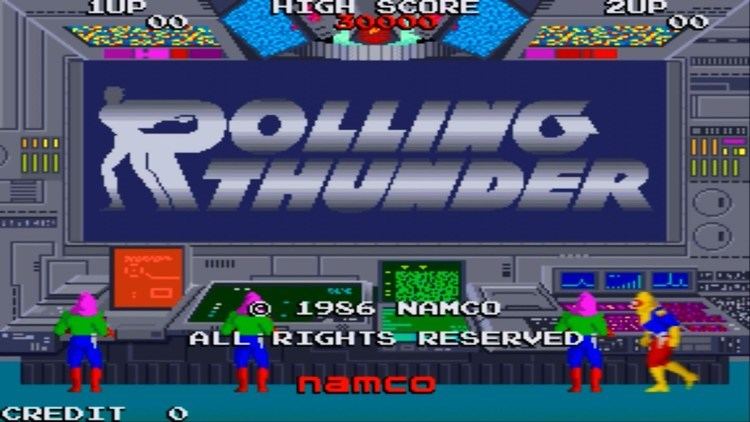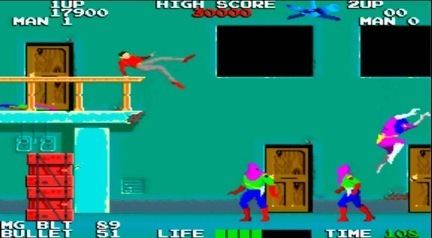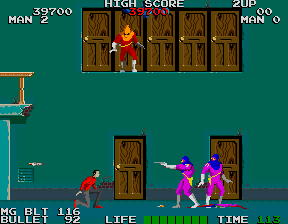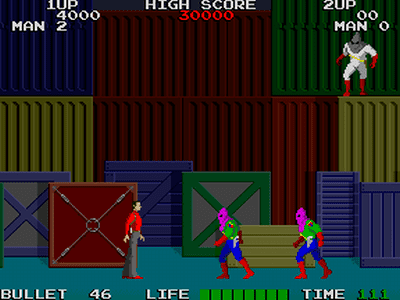Composer(s) Junko Ozawa Genre(s) Run and gun Initial release date 1986 | Series Rolling Thunder | |
Cabinet Upright, cabaret, and cocktail CPU 2x Motorola M6809 @ 1.536 MHz,1x Hitachi HD63701 @ 1.536 MHz Modes Single-player video game, Multiplayer video game (alternating turns) Similar Tengen games, Shooter games | ||
Rolling Thunder (ローリングサンダー, Rōringu Sandā) is a side-scrolling action game produced by Namco (now known as Bandai Namco Entertainment) originally released in as a coin-operated arcade game which ran on the Namco System 86 hardware. It was distributed internationally outside Japan by Atari Games. The player takes control of a secret agent who must rescue his female partner from a terrorist organization. Rolling Thunder was released for various computer platforms in 1987 and the Family Computer and Nintendo Entertainment System in 1989. The original arcade game has also been included in various classic game compilations as well.
Contents

Gameplay

The player takes control of Albatross, a member of the WCPO's (World Crime Police Organization) "Rolling Thunder" espionage unit. Albatross's mission is to save a missing female agent named Leila Blitz from a secret society named Geldra located in New York.

Albatross must travel through two different segments or "stories", each composed of five stages, for a total of ten stages. Depending on the DIP switch settings, the player has the option to start the game from any point in "Story 1" (allowing the player to skip any of the first four stages if desired). On each stage, the player can enter doors to hide and take cover from enemies, as well jump over to higher or lower floors with rails, including stairs. The stages in "Story 2" are essentially harder versions of their "Story 1" counterparts, featuring more traps and different enemy placement. At the end of each stage, scenes from Leila's capture and ensuing torture are shown on a large monitor screen.

The player begins the game armed with a standard-issue pistol, which can be substituted with a fully automatic assault rifle that allows for continuous firing by holding down the shoot button. The player can find ammunition for either weapon by entering doors which are marked "bullets" or "arms". If the player runs out of machine gun ammo, they will switch back to the pistol. However, if the pistol runs out of ammo as well, then the player can only fire a single slow "chaser" bullets on-screen at a time until more ammo is acquired. Despite the presence of a life meter, the player can only take two physical hits from the enemy: a single hit drains half of the meter and the player is killed instantly when struck by a projectile attack such as enemy bullets or lasers, the time reaches 0, and when they fall at any part of an area/level without a floor.

The main enemies in Rolling Thunder are hooded soldiers known as "Maskers". Maskers are dressed in various outfits and colors, which determines their strength and attack pattern respectively. Some Maskers do not shoot, but throw grenades instead, while others will shoot their gun while kneeling. Other enemies includes ninjas, mutated bats known as Gelzos, panthers, shrieking yellow creatures known as Blogas and lava men. At the end of the final stage, the player must battle the Geldra leader Maboo to rescue Leila and complete their mission.
Release
In 1988, U.S. Gold released home computer versions of Rolling Thunder in Europe for ZX Spectrum, Commodore 64, Amstrad CPC, Amiga and Atari ST. These five computer versions were developed by Tiertex. Only the Commodore 64 version had some different colors for the outfit of the Maskers: in the Amiga, Atari ST and Amstrad CPC version the Maskers have all the same outfit colors. ZX Spectrum version was almost monochrome. Slow movements, even slower answer to the controls, jerky scrolling, bad music and many other missing things affected all the versions. The Commodore 64 version was even harder than the original game. Only the ZX Spectrum version had fast gameplay.
On March 17, 1989, Namco released a home version of Rolling Thunder for the Family Computer in Japan. This version was localized in North America by Tengen, which released their version of the game for the Nintendo Entertainment System as an unlicensed title without Nintendo's approval. The Famicom/NES version features a few minor changes and additions from the arcade version, such as a password feature, hidden bonuses, and a harder second mission accessible by inputting a password given to the player for completing the normal mission. Namco's Famicom version of Rolling Thunder also uses a different sound chip from Tengen's NES version that made use of the extra sound channels featured on the Famicom's cartridge slot.
An Atari Lynx conversion of Rolling Thunder was also announced in an official Lynx catalog published. The Lynx version was announced with a scheduled May 1992 release date, but was later canceled.
The original arcade version is featured in Namco Museum Encore for the PlayStation, Namco Museum Battle Collection for the PlayStation Portable, in Namco Museum Virtual Arcade for the Xbox 360, and in Namco Museum 50th Anniversary for PlayStation 2, GameCube, Xbox and PC. The arcade version was released for the Wii's Virtual Console in Japan on July 21, 2009, and as part of the Pac-Man's Arcade Party 30th Anniversary arcade machine in 2010. In March 2012, Rolling Thunder was added to the Namco Arcade (iOS) app.
Reception
Writing for Computer and Video Games, Clare Edgeley wrote that the gameplay in Rolling Thunder is "rather slow" and that she wouldn't recommend it to anyone "keen on a bit of fast action."
In 1996, Next Generation ranked it as the 43rd top game of all time, noting it was a controversial choice.
Sequels
Rolling Thunder was followed by a single sequel for the arcades titled Rolling Thunder 2 in 1990. A Mega Drive version of Rolling Thunder 2 was released in 1991, followed by a Genesis-exclusive sequel titled Rolling Thunder 3, released exclusively in North America in 1993.
